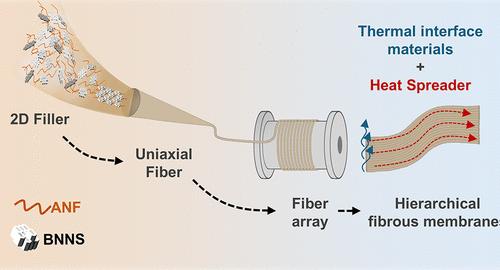Anisotropic Heat Transfer in a Fibrous Membrane with Hierarchically Assembled 2D Materials
IF 8.3
2区 材料科学
Q1 MATERIALS SCIENCE, MULTIDISCIPLINARY
引用次数: 0
Abstract
Effective heat redistribution in specific directions is vital for advanced thermal management, significantly enhancing device performance by optimizing spatial heat configurations. We have designed and fabricated a hierarchical fibrous membrane that enables precise heat directing. By integrating hierarchical structure design with the anisotropic thermal conductivity of two-dimensional (2D) materials, we developed a fibrous membrane for anisotropic heat transfer. Such a structure is fabricated by aligning a 1D structured fiber in the 2D plane to achieve anisotropy at each scale level. The fiber units, where 2D nanosheets circumferentially and axially aligned, achieved a high axial thermal conductivity of 16.8 W·m–1·K–1 and advanced heat directing ability, confirmed by characterizations and simulations. The assembled membrane demonstrated an exceptional tensile strength (365 MPa) and high thermal conductivity (10.5 W·m–1·K–1) along the fiber axis. Our membranes are seen as a refined model for thermal management materials, combining the benefits of heat spreaders and thermal interface materials, thus being proficient in directing heat along programmed pathways. A practical wireless charging cooling demonstration illustrated this. Our methodology also proved versatile with different 2D fillers and various geometries. This research presents a method to achieve precise heat directing at the material’s level, facilitating the systematic design of thermal management in electronics.

带有分层组装二维材料的纤维膜中的各向异性传热
在特定方向上有效地重新分配热量对于先进的热管理至关重要,通过优化空间热配置可显著提高设备性能。我们设计并制造了一种可实现精确热引导的分层纤维膜。通过将分层结构设计与二维(2D)材料的各向异性导热性相结合,我们开发出了一种用于各向异性热传递的纤维膜。这种结构是通过在二维平面上排列一维结构纤维来实现各向异性的。经表征和模拟证实,二维纳米片周向和轴向排列的纤维单元实现了 16.8 W-m-1-K-1 的高轴向热导率和先进的热引导能力。组装后的膜沿纤维轴线具有超强的抗拉强度(365 兆帕)和高导热率(10.5 W-m-1-K-1)。我们的薄膜被视为热管理材料的改良模型,它结合了热传播材料和热界面材料的优点,因此能够沿着编程路径引导热量。一个实用的无线充电冷却演示就说明了这一点。事实证明,我们的方法可用于不同的二维填料和各种几何形状。这项研究提出了一种在材料层面实现精确导热的方法,有助于电子产品热管理的系统化设计。
本文章由计算机程序翻译,如有差异,请以英文原文为准。
求助全文
约1分钟内获得全文
求助全文
来源期刊

ACS Applied Materials & Interfaces
工程技术-材料科学:综合
CiteScore
16.00
自引率
6.30%
发文量
4978
审稿时长
1.8 months
期刊介绍:
ACS Applied Materials & Interfaces is a leading interdisciplinary journal that brings together chemists, engineers, physicists, and biologists to explore the development and utilization of newly-discovered materials and interfacial processes for specific applications. Our journal has experienced remarkable growth since its establishment in 2009, both in terms of the number of articles published and the impact of the research showcased. We are proud to foster a truly global community, with the majority of published articles originating from outside the United States, reflecting the rapid growth of applied research worldwide.
 求助内容:
求助内容: 应助结果提醒方式:
应助结果提醒方式:


